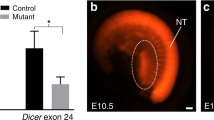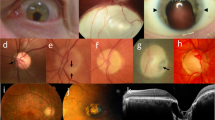Abstract
Congenital Anomalies of the Kidney and Urinary Tract (CAKUT) encompass a spectrum of kidney and urinary tract disorders. Here, we describe two assays that can be used to determine if a mouse has vesicoureteric reflux (VUR) or urinary tract obstruction, two urinary tract defects observed in CAKUT. To test for VUR, dye is injected into the mouse bladder and then monitored to determine if it passes retrogradely from the bladder towards the kidneys, indicating the presence of VUR. To test for urinary tract obstruction, the renal pelvis is microinjected with dye and its passage along the urinary tract is monitored to determine if there is evidence of impaired flow along the tract. These methods will facilitate the analysis of CAKUT phenotypes in the mouse.
Access this chapter
Tax calculation will be finalised at checkout
Purchases are for personal use only
Similar content being viewed by others
References
Batourina E, Choi C, Paragas N et al (2002) Distal ureter morphogenesis depends on epithelial cell remodeling mediated by vitamin A and Ret. Nat Genet 32:109–115
Young B, Heath JW (2000) Wheater’s functional histology, 3rd edn. Harcourt Publishers, Edinburgh
Campbell M (2002) Campbell’s urology, 8th edn. Saunders Harcourt Publishing, Philadelphia
David SG, Cebrian C, Vaughan ED Jr, Herzlinger D (2005) c-kit and ureteral peristalsis. J Urol 173:292–295
Mendelsohn C (2004) Functional obstruction: the renal pelvis rules. J Clin Invest 113:957–959
Batourina E, Tsai S, Lambert S et al (2005) Apoptosis induced by vitamin A signaling is crucial for connecting the ureters to the bladder. Nat Genet 37:1082–1089
Tanagho EA, Guthrie TH, Lyon RP (1969) The intravesical ureter in primary reflux. J Urol 101:824–832
Schedl A (2007) Renal abnormalities and their developmental origin. Nat Rev Genet 8:791–802
Murawski IJ, Myburgh DB, Favor J, Gupta IR (2007) Vesico-ureteric reflux and urinary tract development in the Pax21Neu+/− mouse. Am J Physiol Renal Physiol 293:F1736–F1745
Burger RH, Smith C (1971) Hereditary and familial vesicoureteral reflux. J Urol 106: 845–851
Chapman CJ, Bailey RR, Janus ED, Abbott GD, Lynn KL (1985) Vesicoureteric reflux: segregation analysis. Am J Med Genet 20:577–584
Chen F (2009) Genetic and developmental basis for urinary tract obstruction. Pediatr Nephrol 24:1621–1632
Murakumo M, Nonomura K, Yamashita T et al (1997) Structural changes of collagen components and diminution of nerves in congenital ureteropelvic junction obstruction. J Urol 157: 1963–1968
Hodson EM, Wheeler DM, Vimalchandra D, Smith GH, Craig JC (2007) Interventions for primary vesicoureteric reflux. Cochrane Database Syst Rev CD001532
(1981) Medical versus surgical treatment of primary vesicoureteral reflux: report of the International Reflux Study Committee. Pediatrics 67: 392–400
Sengar DP, Rashid A, Wolfish NM (1979) Familial urinary tract anomalies: association with the major histocompatibility complex in man. J Urol 121:194–197
Mannen H, Tsuji S, Goto N (1991) Incomplete protection mechanism against vesico-ureteral reflux and hydronephrosis in the inbred mouse strain DDD. Lab Anim 25:156–161
Nishimura H, Yerkes E, Hohenfellner K et al (1999) Role of the angiotensin type 2 receptor gene in congenital anomalies of the kidney and urinary tract, CAKUT, of mice and men. Mol Cell 3:1–10
Pedersen A, Skjong C, Shawlot W (2005) Lim 1 is required for nephric duct extension and ureteric bud morphogenesis. Dev Biol 288:571–581
Paredes J, Sims-Lucas S, Wang H et al (2011) Assessing vesicoureteral reflux in live inbred mice via ultrasound with microbubble contrast agent. Am J Physiol Renal Physiol
Hains DS, Sims-Lucas S, Carpenter A et al (2010) High incidence of vesicoureteral reflux in mice with Fgfr2 deletion in kidney mesenchyma. J Urol 183:2077–2084
Murawski IJ, Maina RW, Malo D et al (2010) The C3H/HeJ inbred mouse is a model of vesico-ureteric reflux with a susceptibility locus on chromosome 12. Kidney Int 78:269–278
Yu OH, Murawski IJ, Myburgh DB, Gupta IR (2004) Overexpression of RET leads to vesicoureteric reflux in mice. Am J Physiol Renal Physiol 287:F1123–F1130
Author information
Authors and Affiliations
Corresponding author
Editor information
Editors and Affiliations
Rights and permissions
Copyright information
© 2012 Springer Science+Business Media, LLC
About this protocol
Cite this protocol
Murawski, I.J., Watt, C.L., Gupta, I.R. (2012). Assessing Urinary Tract Defects in Mice: Methods to Detect the Presence of Vesicoureteric Reflux and Urinary Tract Obstruction. In: Michos, O. (eds) Kidney Development. Methods in Molecular Biology™, vol 886. Humana Press, Totowa, NJ. https://doi.org/10.1007/978-1-61779-851-1_31
Download citation
DOI: https://doi.org/10.1007/978-1-61779-851-1_31
Published:
Publisher Name: Humana Press, Totowa, NJ
Print ISBN: 978-1-61779-850-4
Online ISBN: 978-1-61779-851-1
eBook Packages: Springer Protocols




